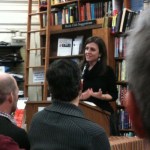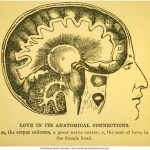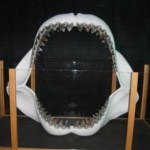history of science
Anatomy Lesson of Dr. Tulip, Rembrandt (1632)I have been extremely ill this week which has prevented me from posting as often as I would have liked. However, I have been keeping up on the suggestions offered to explain the nearly 300-year-old medical mystery involving "hairy crustaceous substances" voided in a woman's urine. Of all the potential explanations for this phenomenon I think Quinn O. nailed it with his diagnosis of pilimiction as the result of a dermoid tumor. In doing a little research on this condition I discovered that this is caused…
Way back in 2007, when I was still a neophyte science blogger, Rutgers University philosophy professor Jerry Fodor published an op-ed in the London Review of Books called "Why Pigs Don't Have Wings." It was a critique of a straw man version of evolutionary theory characterized by a brand of adaptationism so narrow that (if it were at all true) biologists could be charged with just making things up as they went along. But Fodor was not so much concerned with science as the extension of evolutionary ideas outside of biology. Motivated by his irritation with evolutionary psychology, a…
An engraving of Koch's "Hydrarchos", from the American Phrenological Journal. (Pardon the smudges)
In July of 1845 the amateur fossil hunter Albert Koch brought his sea monster to New York City. A cousin of the serpentine creatures that so many had claimed to see off the coast of New England, the 114-foot-long skeleton looked to be the bones of the Leviathan itself, and crowds flocked to see the its ghastly form. It was called "Hydrarchos" by Koch, and it was was the ruler of the ancient seas.
It was also a monstrous hoax. The Hydrarchos skeleton did not belong to any one animal but to…
Detail of a Charles R. Knight mural depicting a family a mastodons.
Fossils often turn up in unexpected places. As people have dug swimming pools, tilled farms, blasted through mountains, and quarried the land for minerals traces of ancient life sometimes come to the surface, from isolated shark teeth to skeletons of our extinct hominin relatives. Even fossil graveyards are found this way every now and then, like the one found in a southern Pennsylvania quarry a little more than a century ago.
In late April 1907 William Jacob Holland, a paleontologist and director of Pittsburgh's Carnegie…
Last week, I braved a nasty sleety Cambridge evening to see Rebecca Skloot read from her excellent new book, The Immortal Life of Henrietta Lacks. I'm thrilled to tell you it's finally being released on Amazon tomorrow, so if you haven't already been to your local bookstore, go snag a copy (or enter to win one from Sb, through 2/23/10!)
In case you don't know the story, Henrietta Lacks was a young African-American mother who was stricken with a particularly invasive form of cervical cancer back in the early 1950s. She died within months, but her cancer cells remain alive today - millions of…
Contingency has been on my mind quite often these days. What would life look like today if the ancestors of the first land-dwelling vertebrates had two legs instead of four? How would non-avian dinosaurs continue to have evolved if they had not been wiped out 65 million years ago? What if, like many other prehistoric apes, our own ancestors fell into extinction during the Pliocene? Any one of these events would have changed the history of life on earth, and even though there are not answers to these questions they still remind me of how historical quirks can have major effects.
Though it has…
Last week, The Poisoner's Handbook got a great, pre-publication review in one of my favorite magazines, New Scientist. I was thrilled - and relieved. Hard to say which came first. The week before publication - the book's official date is Feb. 22 - always makes me a little crazy.
But much as I like my work being called "fascinating" (and I do, I do), it was the closing sentence of the review that really spoke to me: "Alas, sometimes the poisoners we seek are ourselves." Collins was referring to the findings by the 1920s toxicologist in my book that carbon monoxide was…
From the Cold Spring Harbor Archive (click for larger image). From Micklos, The Science of Eugenics, pg 116 (1930).
Last night, braving horrible traffic on the way there, and snow on the way back, I made my way to the N.C. Museum of Natural Sciences for the Darwin Day shark lecture co-organized by NESCent and the sneak preview of the Megalodon exhibit which officially opens today.
I have to say that the trip was very much worth making - the exhibit is excellent! I like the way the exhibit is making good use of the space - so many exhibits feel cluttered and an all-out assault on all of one's senses. Upon entering the room, it looks quite sparse. Yet, once I started going around I saw how much it actually…
This afternoon, I'll be driving down to Raleigh to the N.C. Museum of Natural Sciences for the special Darwin Day event organized in collaboration with the National Evolutionary Synthesis Center.
The evening will start with the sneak-peak pre-opening of the Megalodon exhibit which opens to the public tomorrow. Megalodon was the largest shark ever discovered in the fossil record and the exhibit will, apart from its massive jaws, showcase the evolution of sharks, modern sharks and the conservation issues facing these magificient fish today:
At 60 feet long, Carcharodon megalodon was the…
The Poisoner's Handbook, is out next week and in a recent interview I found myself trying to explain why I'm now writing about poison and murder when my last book was about supernatural research and the one before that about the biology of love and affection.
I know, it sounds like I have a short attention span. Usually I explain that these topics are all connected by my fascination with the way science and society intersect, the way science changes our world, the way our culture responds. But this time I found myself replying: " I'm a really good friend to dead scientists."
This…
Here are some of the thoughts and questions that stayed with me from this session. (Here are my tweets from the session and the session's wiki page.)
The session was led by John McKay and Eric Michael Johnson. John posted the text of his presentation and Eric posted his presentation a la YouTube. I'm going to take this as permission to skip doing a proper recap here. Instead, I'm going to write about the big ideas this session raised for me.
First, I'm struck by how easy it is for those of us who were trained to do science to know very little about where scientific practices come from --…
After watching Creation last week I decided to take the plunge and read Origin of Species. As I've mentioned before I did read Origin early in my teen years, but in hindsight with minimal comprehension. Since then I've occasionally started to read Origin, or perused an extract, but I've never made it from front to back as a sentient adult. At this point I'm 3/4 of the way through, and I need to get something off my chest: I now believe that Charles Darwin was a very smart man, a genius. I had heard other people to refer to Darwin in such a fashion, but reading his original works has brought…
This week on PRI/BBC World Science:
This month, the movie Creation opened in theaters across the United States.
The film chronicles the life and work of Charles Darwin.
The movie is directed by Jon Amiel. Paul Bettany stars as Darwin. Jennfer Connelly plays Darwin's wife, Emma.
Creation is based on a biography written by Charles Darwin's great great grandson, Randal Keynes.
Keynes is a conservation biologist who lives in London.
The World's science correspondent, Rhitu Chatterjee, spoke with Keynes about his famous ancestor and the experience of seeing his book turned into a movie.
Listen to…
One of the nice benefits of hosting ScienceOnline conferences is that I sometimes get presents. The one that I find totally fascinating that I got this year is the 2009 issue of Phlogiston, the Journal of History of Science published once a year in Serbian language - print only (the journal does not even have a homepage).
I got this issue from Jelka Crnobrnja-Isailovic who came all the way from Serbia to do a session on challenges to Open Access in developing countries together with her friend and colleague Tatjana Jovanovic-Grove.
The 2009 issue of Phlogiston is dedicated to Darwin and the…
So many books, articles, and documentary films have been produced about the life of Charles Darwin that it is difficult to keep track of all the Darwiniana, but the recently-released feature film Creation is something special. It is not a straight biography, nor is it an entirely fictionalized account. Instead it is an amplified version of a challenging time in Darwin's life which largely eschews intricate details in favor of broad, powerful strokes.
Viewers hoping for a 100% historically-accurate dramatization of Darwin's life will be disappointed from the very first scene. The film opens…
Speakeasy bar, 1933
I love the cocktails of the 1920s, invented by Prohibition-era mixologists trying to cover up the taste of bathtub gin. The Bee's Knees, which stirs lemon juice and honey in with the liquor; the Sidecar (personal favorite) which blends lemon juice and orange-infused liqueurs like Cointreau with whiskey. At one point I acquired the 1930s Savoy Book of Cocktails thinking to gain even more, um, experience.
I gave it up up though. Those Jazz-Age cocktails are just too potent. During Prohibition (1920-1933), of course, they were even more so because the bootlegged…
The famous apple-tree story, from a manuscript by one of Newton's friends:
"After dinner, the weather being warm, we went into the garden and drank tea, under the shade of some apple trees. [Newton] told me, he was just in the same situation, as when formerly, the notion of gravitation came into his mind. It was occasion'd by the fall of an apple, as he sat in contemplative mood.'Why should that apple always descend perpendicularly to the ground,' thought he to himself. 'Why should it not go sideways, or upwards? But constantly to the earth's centre? Assuredly, the reason is, that the earth…
Madonna and Child with Angels, AKA "Madonna with the Long Neck"
Parmigianino, c. 1534/40
From Edward Winkleman's blog, a good post about yet another art historian with convenient medical explanations for the artistic idiosyncrasies of the old masters. In addition to arguing that the Mona Lisa had high cholesterol, the historian has an even more timely link to current events:
Among his other findings are that two of the most iconic figures in Renaissance art had a rare condition that may also afflict Osama Bin Laden. One is the young man with a red cap and distinctly sardonic expression who…
Tiktaalik is practically a household name. Since its description in 2006 the flat-headed "fishapod" has appeared in books, on t-shirts, and has even starred in its own music video. Hailed as a "missing link", Tiktaalik has become a poster child fossil for evolution, but it is hardly the first such creature to be given this honor.
Way back in the 1840's, well over a decade before Charles Darwin's On the Origin of Species was published, the Victorian anatomist Richard Owen was mulling over the concept of transitional forms. He was not so much thinking about actual fossils as the way anatomical…




